skip to main |
skip to sidebar
This post is dedicated to a dear blogger whose every post reflects her sincerity and sweetness - Linda OutOfTheGarden(AndLatelyByTheLake). If it hadn't been for her timely rant, you wouldn't be reading this - because there wouldn't have been anything to read. Oh by the way, do read her rant - you'd be hard pressed to find a gentler, sweeter one! When I rant, I rant; when Linda rants... well, she's as likable as ever!
About this recipe, it was meant to be mild and mostly monochrome (white turnip, white pasta, white onion, white mushrooms) but I decided to greenify it a bit by adding spinach and rocket (love the stuff) and a tiny touch of red and heat by way of a fresh red chilli - and then some crunch in the form of pine nuts... and pretty soon it wasn't the original recipe any more. It was better (she said humbly).
Recipe for: Farfalline with turnip, mushrooms and greens
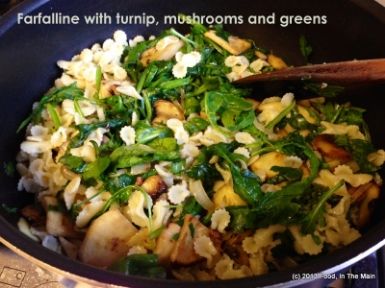
Ingredients:
1/2 cup farfalline or orzo pasta
1 medium turnip, peeled and sliced about 1/4 cm thick and each slice quartered
1 small onion or 2 banana shallots, chopped fine
1/3 cup chestnut mushrooms, sliced
Good handful of spinach leaves, torn
Good handful of rocket leaves
1 red chilli, minced very fine (optional)
1 fat clove garlic, sliced
1 tsp butter
2 tsp olive oil
Salt and pepper to taste
2 tbsp basil and parsley, sliced
1 tbsp toasted pine nuts, for garnish
Method:
1. Cook the orzo/farfalline according to directions in plenty of boiling salted water. Drain, toss with a little olive oil and set aside.
2. Heat 1 tsp oil in a pan and add the garlic, chillies and shallots and stir. Cook over medium heat until the shallots are soft and light brown. Remove from the pan and set aside.
3. In the same pan, heat the remaining oil and butter, add the sliced turnip and mushrooms. Fry until they're golden brown, about 7-8 minutes.
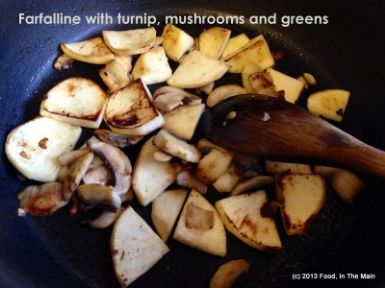
4. Add the cooked shallots to the pan and mix them in. Toss in the spinach and rocket, then stir in the cooked pasta. Add salt and pepper to taste. Stir in the basil and parsley, scatter over the pine nuts, and serve hot or at room temperature.
Tell you what, I'm really enjoying baking bread. I can say quite definitively that I'm no longer afraid of working with yeast - instant or fresh. I've actually got into the rhythm of baking two loaves of bread (sometimes three) pretty much every other Saturday. They're mostly a mix of white and wholewheat bread for everyday use, and sometimes I bake a third loaf which might be a flavoured one, to go with soups and suchlike.
The bread loaves get sliced - and I'm getting pretty good at cutting even, thin slices, even if I do say so myself - divided into half-loaves and fed to the freezer, stored in bags labelled with the date of baking. That way I get to rotate recycle use up the bread, oldest ones first. Yep, I'm THAT organised. It's kind of disconcerting, even to me. Or especially to me, because only I know just how alien this behaviour is to me.
Now that you've all been made aware of my weekend baking activities and the resulting follow-ons - which information I'm sure has been of great interest, by the way - let's get to the sundried tomato and roasted garlic bread that is today's recipe. By rights it should have been posted two months back, because that's about when I made it... but never mind that. The bread is really nice with soup, but I was happy to eat it by itself, with no adornments, because it was that tasty. Can't say better than that, can I?
By the way, if you don't like a strong garlic flavour, use less of the roasted garlic paste... and if your thing is to wilt every living thing within a 10-metre radius with your breath, by all means use MORE garlic paste, as much as you want. At least Dracula won't get you.
Recipe for: Sundried tomato and roasted garlic bread

Ingredients:
3-1/2 cups (15 oz) strong white bread flour
2-3 tbsp olive or other oil of choice
2 tbsp double concentrated tomato paste
1 tbsp roasted garlic, roughly mashed
1/4 cup chopped sundried tomatoes in oil (but leave out the oil)
1 htsp salt
About 300 ml warm water
1/2 tbsp instant yeast
Method:
1. Place the flour in a deep bowl and mix in the instant yeast and salt.
2. Then add the roasted garlic, tomato paste, and chopped sundried tomatoes
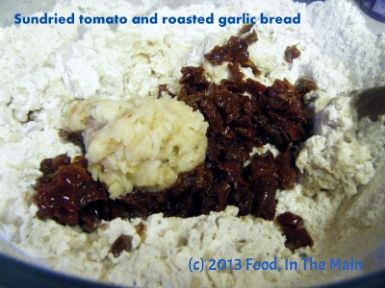
along with 250 ml of the warm water and mix together till the flour begins to form a rough dough. Cover and let it rest for 10 minutes to absorb the water.
3. Now knead again, adding as much of the remaining 50ml water as required, to make a dough that is not exactly sloppy but also not hard or dry either.
4. Pour 1 tbsp olive oil on your worktop (make sure your worktop is clean first!) or kneading board and spread it around a bit. Turn the dough out onto the oil and start kneading, pushing the dough away from you with the heel of your hand, turning it a quarter, then repeating the pushing/turning movement. Add more oil to the worktop if the dough starts sticking again, and continue kneading. Occasionally scrape your hand clean of dough.
5. After about 8-10 minutes, the dough should be elastic and only a little tacky. Now grease a large bowl (I use Pam spray, but you can use more oil if you like) and place the dough in it, turning it around to completely coat it in the oil. Cover the bowl and place in a warm place for the dough to rise and more or less double in volume. This can take between 1-2 hours, or even longer - there's no way to accurately predict how long it might take, so I can't give you a precise time.
6. Once the dough is risen, punch it back down. Sprinkle a couple of tbsp extra flour on your workspace and put the dough on it. Shape it into a round ball, place on a baking tray (flour the top of the dough lightly if you like) and cover with a clean tea-towel. Let the dough rise again for 45 min to an hour. Use a sharp knife to slash a 1-cm deep cross into the top.
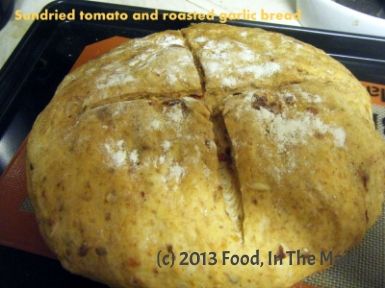
7. Preheat your oven to 180C/350F and put the dough in to bake. Let it bake for 25-30 minutes - the top should be a nice golden brown and the bottom should sound hollow when tapped.
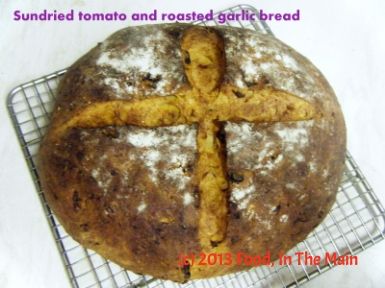
Remove the loaf to a wire cooling rack and let cool completely. Serve sliced, with soup.
(Adapted from King Arthur Flour)
First off, I have to apologise for the delay in posting my version of this month's challenge - actually, last month's, now. In my defence, my laptop was on a dreadful go-slow, and on top of that, the Internet connection at home was unavailable all of last week as we'd changed over from AOL to BT... and the engineer from BT could only come last Friday to actually install whatever he needed to install for us to go online. So now we have a superfast connection... but my laptop has not received the memo yet, methinks. It's extremely frustrating to work on photographs when it takes 5 minutes to save every change that's made. But this post had to be published, and I didn't want to risk being thrown out of this group for a perceived lack of participation. (I but jest, I know Aparna is very forgiving!)
Anyway, those of you who are still dropping by my blog might be wondering who's been writing my posts for me. I wonder that myself, because the last few posts show every sign of having been dashed off by someone who didn't know how to write, who didn't want to write in the first place and who had a dozen different distractions. That was me. Distracted and reluctant. And it showed in my writing - hastily done for the sake of doing it, not because I was enjoying the process. I'm still in the reluctant phase, so this probably isn't going to be a long post. I just wanted to make my excuses for the quality of my posts lately. I know I can do better, and I probably eventually will.
On to the bialys. I've made them twice - they're pretty easy to make, but the reason I made them the second time is because the onion filling got burnt practically to cinders. My first mistake was to cook the onions for too long on the hob, and my second mistake was to leave the overcooked onions to cool in the frying pan itself. That was a rookie mistake, really. So the already overcooked onion simply got incinerated when they spent 20 minutes in a 230C oven. The bialys tasted great, so Pete and I ate the bready part after I'd chiselled off the charred onions.
This anecdote is merely to emphasise that it's very important to cook the onions till just soft and no more. And remove the cooked onions to a bowl where they can cool.
The second batch of bialys was spectacularly tasty. You can add chopped, cooked smoked bacon to the onion mix for the non-vegetarians, like I did. Believe me, those bacon bialys just vanished.
Recipe for: Bialys

Ingredients:
For the dough:
1 teaspoon instant yeast
1 tbsp sugar
1 1/4 cup warm water
3 cups all-purpose flour (use bread flour if you can find it or all-purpose flour + 1 tbsp vital wheat gluten)
1 tsp salt
Milk for brushing the dough
For the Onion Filling:
1 tbsp oil
3 medium onions, finely chopped
1 1/2 tsp cumin seeds
3/4 tsp garam masala
Salt to taste
Method:
1. Make the dough first. Put the yeast, sugar, salt and flour in a large bowl. Mix well and then add the warm water in a steady stream. Knead until the dough comes together as a mass and then let the dough rest for 10 minutes. This will help the dough absorb water. Knead again, adding a little more water or flour (not too much) if you need it, until your dough is smooth and elastic but not sticky.
2. Shape tre dough into a ball and put it in a well-oiled bowl, turning the dough till it is well coated. Cover and let it rise till about double. This should take about 2 hours. If you’re not making the bialys right away, you can refrigerate the dough overnight at this point. When ready to make them, keep the dough at room temperature for about half an hour and then proceed with the rest of the recipe.
3. In the meantime, make the filling. Heat the oil in a pan, and add the cumin seeds. When the crackle, add the onions, and sauté over low to medium heat. Sprinkle a little salt and continue sautéing until they become soft and turn golden brown in colour. Add the garam masala and stir well. Keep the caramelised onions aside to cool.
4. Sprinkle your work surface lightly with flour and place the dough on it. Divide it into 8 equal pieces and shape each one into a roll by flattening it and then pinching the ends together to form a smooth ball. Place the rolls on a lightly greased baking sheet and cover them with a towel. Let them rise for about one hour (about 1 1/2 to 2 hours for refrigerated dough) till pressing with a finger on the top leaves a dent.
5. Work on one piece at a time, while you keep the others covered so they don’t dry out. When the rolls are ready, pick them up one at a time and using your fingers, form the depression in the middle. Hold the roll like a steering wheel with your thumbs in the middle and your fingers around the edges. Pinch the dough between your thumb and fingers, rotating as you go and gradually making the depression wider without actually poking a hole through.
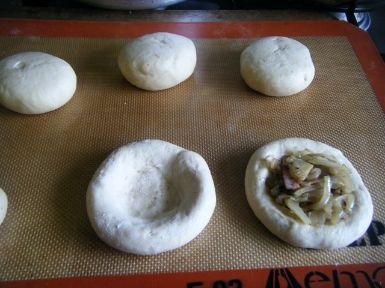
6. Remember not to press on the edges, or they will flatten out. Once shaped, you should have a depression about 3” in diameter with 1” of puffy dough around the edge, so your Bialy should be about 4” to 5” in diameter. Prick the centre of the bialys with a fork so the centre doesn’t rise when baking.
7. Place the shaped dough on a parchment lined (or greased) baking tray leaving about 2 inches space between them. Place the caramelised onion filling in the depressions of each Bialy. Brush the outer dough circle with milk. Bake the bialys at 230C (450F) for about 15 minutes till they’re golden brown in colour.

Cool them on a rack. Serve slightly warm or at room temperature.
(Adapted from A Baker’s Tour by Nick Malgieri)
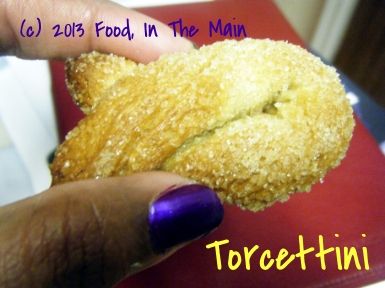
Cookies are not my thing. I might have tried baking cookies maybe a scant 2 dozen times in the last 10 years (or since I started cooking, anyway). Not always successfully, I might add. There aren't many biscuits that have come out well, except for the multiple batches of ginger biscuits that I baked last Christmas, much to Pete's satisfaction. Pete loves ginger biscuits, but not really any others. As for me, I'm no cookie monster!
Anyway - these yeasted cookies were pretty easy to make. Like most everyone else, we both liked the sugar crust and the caramelised underside of the cookies. They were different from anything I've had before, that's for certain!
And one more thing - I'm glad I've managed to post this recipe before the end of April. I missed the publish date of 24th April because of a combination of circumstances, the most distressing one being a bereavement in the family. Still... it's a part of the cycle of life, I suppose, and life being what it is, it must go on. So... onward to May's challenge!
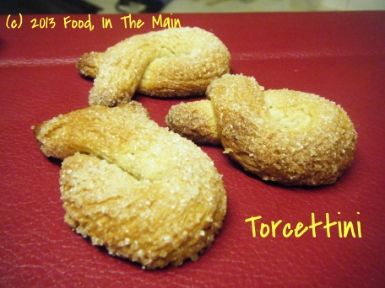 Ingredients:
Ingredients:
1/2 cup warm water
1-1/4 tsp active dry yeast (or 1 tsp instant yeast)
1-1/2 cups all-purpose flour
1/4 tsp salt
1 tsp lime/lemon zest or 1 tsp crushed anise seeds
2-1/2 tbsp unsalted butter, cold and cut into small pieces
about 1/3 cup granulated sugar for rolling the cookies
Method:
1. Dissolve the yeast in the warm water, in a small bowl and keep aside.
2. Put the flour and the salt in a large bowl and stir everything together. Add the butter pieces and pulse until the butter is well mixed and the flour-butter mixture looks powdery.
3. Add the yeast-water mixture and knead just till it all comes together as a ball. Place the ball of dough in a oiled bowl, turning it so it is well coated with the oil. Cover the bowl, and let the dough rise. This dough does not really double in volume, but it should look “puffy” after about an hour or so. When you pinch off a bit from the top you can see the interior looking a bit like honeycomb. Press down the dough to deflate it, wrap it in cling wrap and refrigerate it for at least one hour or up to 24 hours.
4. When ready to make the cookies, take the dough out and lightly roll it out into an approximately 6” square. If the dough feels sticky, scatter a little sugar on it. Using a pizza wheel cut the dough into four strips of equal width. Cut each strip into 6 equal pieces, by cutting across, making a total of 24 pieces. The measurements are not very critical in this part because this just makes it easier to have 24 equal sized bits of dough, as compared to pinching of bits of the dough.
5. Roll each piece into a pencil thick “rope” about 5” long. Sprinkle a little sugar on your work surface and roll the “rope” in it so the sugar crusts the dough uniformly. Form the “rope” into a loop crossing it over before the ends.
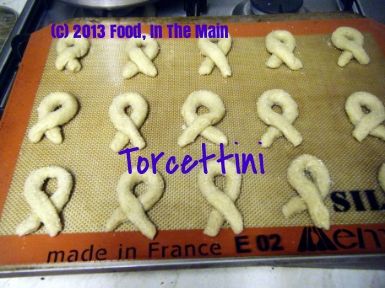 6. Place the Torcettini on parchment lined baking sheets, leaving 1-1/2" between them. Leave them for about 20 minutes or so till they rise/ puff up slightly. They will not “puff up” much, like bread, but the “puff” will be visible.
6. Place the Torcettini on parchment lined baking sheets, leaving 1-1/2" between them. Leave them for about 20 minutes or so till they rise/ puff up slightly. They will not “puff up” much, like bread, but the “puff” will be visible.
7. Bake them at 160C (325F) for about 25 minutes till they’re a nice golden brown.
 Cool the cookies completely, on a rack. Store them in an air-tight container at room temperature.
Cool the cookies completely, on a rack. Store them in an air-tight container at room temperature.
I keep hearing things about roasted garlic... good things, like how lovely and mellow it tastes, and how it's perfect as a spread straight onto fresh French bread, etc etc. It's not a new thing, obviously. I must confess that this is not the first time that I've roasted garlic bulbs whole. It's actually the second time. And the reason that there's been a gap of a few years between the first attempt and this one is that I sodhapufied (ruined, in Tamil slang) it big time. The garlic was absolutely disgusting, bitter to the core. After that I was too nervous to try again, although I thought about it every so often.
Then I bought 3 bulbs of smoked garlic on an impulse, with no real idea of what to do with them... until it struck me that I could roast them. This time, I was careful to cover the garlic with foil and to roast the heads at 180C for about 30 minutes. This time, probably because I was careful, the roasted garlic was just wonderful - it slipped out of its papery skin without a problem, it smelt gorgeous, and I must have eaten a full head by myself without really realising it, it was that good. The rest of the bulb I used to make a garlic and tomato bread... but that's for another post.
PS. You don't have to use smoked garlic; regular garlic will do just as well.
Recipe for: Roasted smoked garlic
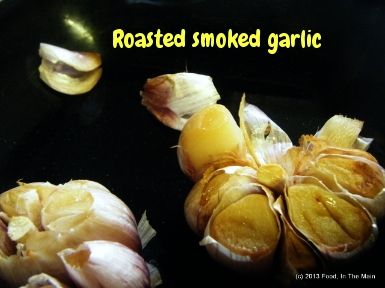
Ingredients:
3 heads of smoked garlic
3 tsp olive oil
Method:
1. Peel the garlic until you're down to the single skin covering the bulbs. Slice off the top of the bulbs to expose the white flesh within.
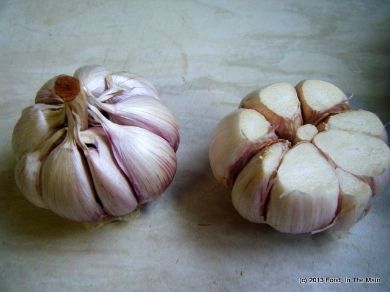
2. Drizzle one tsp olive oil over each cut head of garlic. Place in a small baking tray and cover the top tightly with foil.
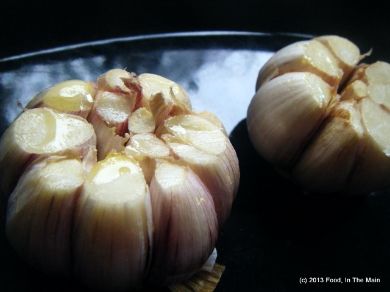
3. Bake at 180C (350F) for 20-30 minutes, or till a knife inserted into a garlic pearl goes in easily. Remove from the oven and let cool slightly before squeezing the inner flesh from the papery skin (carefully, as it can still be very hot). Use the roasted garlic in cooking, or just smear it on a baguette with a little salt.
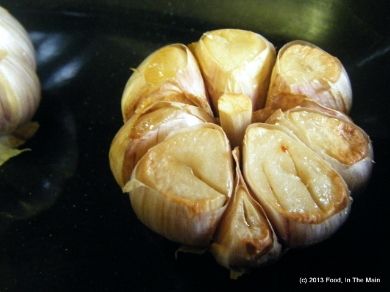

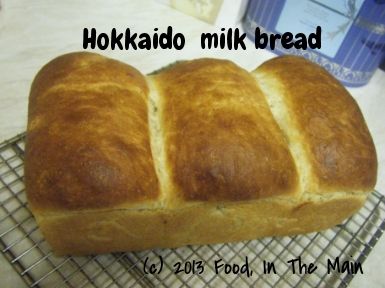 Last month's baking challenge saw me at my whiny worst, because the croissants that we were supposed to make nearly got the better of me. But I persevered, rather to my surprise, and at least I can say "I tried it". This month's challenge was much more in keeping with my ability and my interest, because I can make bread. I can knead dough. I've been experimenting with different types of bread, with different proportions of strong white, wholewheat, wholemeal spelt and wholemeal rye flours. Mostly they've been successful bakes.
Last month's baking challenge saw me at my whiny worst, because the croissants that we were supposed to make nearly got the better of me. But I persevered, rather to my surprise, and at least I can say "I tried it". This month's challenge was much more in keeping with my ability and my interest, because I can make bread. I can knead dough. I've been experimenting with different types of bread, with different proportions of strong white, wholewheat, wholemeal spelt and wholemeal rye flours. Mostly they've been successful bakes.
That is why this Hokkaido bread didn't faze me. Yes, the dough was irritatingly sticky. Yes, I kneaded the dough by hand, because I don't have a machine to do the job... but to be fair, I didn't put my entire being into the kneading. That's because of the technique recommended by Dan Lepard of the Guardian newspaper (jeez, the number of times I've mentioned this man in my posts, he should be paying me a commission!).
Anyway, I didn't do a 10-second knead with this dough, but I certainly didn't knead for 15 minutes at a time either. It turned out so soft and buttery, it was unbelievable. I made one big loaf, and some Nutella rolls and some with a spicy potato filling. They all turned out incredibly moreish. I'm planning to use the tangzhong technique with regular baking flours rather than just all-purpose. The tangzhong will continue to be made with AP flour, though. However, that's for another post. In the meantime, thank you once again, Aparna Balasubramanian, for introducing me to this bread technique that was completely new to me.
Recipe for: Hokkaido milk bread
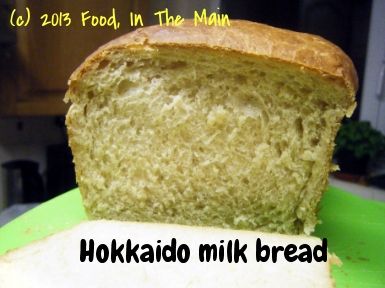 (Original Recipe from 65 Degrees Tangzhong “65C Bread Doctor” by Yvonne Chen, and adapted from Kirbie’s Cravings)
(Original Recipe from 65 Degrees Tangzhong “65C Bread Doctor” by Yvonne Chen, and adapted from Kirbie’s Cravings)
http://kirbiecravings.com/2011/05/hokkaido-milk-toast.html
Ingredients:
For The Tangzhong (Flour-Water Roux)
1/3 cup all-purpose flour
1/2 cup water
1/2 cup milk
For The Dough:
2 1/2 cups all-purpose flour
3 tbsp sugar
1tsp salt
2 tbsp powdered milk
2 tsp instant dried yeast
1/2 cup milk (and a little more if needed)
1/8 cup cream (25% fat)
1/3 cup tangzhong (use HALF of the tangzhong from above)
1/4 tsp salt
25gm unsalted butter (cut into small pieces, softened at room temperature)
1/2 to 3/4 cup mini chocolate chips if making the rolls
Method:
The Tangzhong (Flour-Water Roux):
Whisk together lightly the flour, water and milk in a saucepan until smooth and there are no lumps. Place the saucepan on the stove, and over medium heat, let the roux cook till it starts thickening. Keep stirring/ whisking constantly so no lumps form and the roux is smooth.
If you have a thermometer, cook the roux/ tangzhong till it reaches 65C (150F) and take it off the heat. If like me, you don’t have a thermometer, then watch the roux/ tangzhong until you start seeing “lines” forming in the roux/ tangzhong as you whisk/ stir it. Take the pan off the heat at this point.
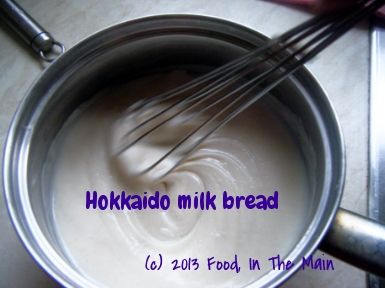
Let the roux/ tangzhong cool completely and rest for about 2 to 3 hours at least. It will have the consistency of a soft and creamy crème patisserie. If not using immediately, transfer the roux to a bowl and cover using plastic wrap. It can be stored in the fridge for about a day. Discard the tangzhong after that.
The Bread Dough:
I made this bread by hand. This dough dough is a bit sticky and can take some time and effort to knead by hand. If you have some sort of machine which will do the kneading for you, use it. Don’t punish yourself. And do not add more flour to make it less sticky either!
Put the flour, salt, sugar, powdered milk and instant yeast in a large bowl and pulse a couple of times to mix. In another small bowl mix the milk, cream and Tangzhong till smooth and add to the bowl. Mix with a wooden spoon until the dough comes together. Now add the butter and knead till you have a smooth and elastic dough which is just short of sticky.
The dough will start out sticky but kneading will make it smooth. If the dough feels firm and not soft to touch, add a couple of tsps of milk till it becomes soft and elastic. When the dough is done, you should be able to stretch the dough without it breaking right away. When it does break, the break should be form a circle.
Form the dough into a ball and place it in a well-oiled bowl turning it so it is well coated. Cover with a towel, and let the dough rise for about 45 minutes or till almost double in volume.
Place the dough on your working surface. You don’t need flour to work or shape this dough. This recipe makes enough dough to make one loaf (9” by 5” tin), 2 small loaves (6” by 4” tins) or 1 small loaf (6” by 4”) and 6 small rolls (muffin tins). Depending on what you are making, divide your dough. If you are making 1 loaf, divide your dough in 3 equal pieces. If you are making two smaller loaves, divide your dough into 6 equal pieces.
The shaping of the portions, whether for the loaf or the rolls, is the same.
Roll out each portion of the dough with a rolling pin into an oval shape, about 1/8” thick. If you are using a filling, spread it on the dough now, before shaping it into a ball with your hands, bringing the edges to cover the filling.
Roll this folded dough with the rolling pin so the unfolded edges are stretched out to form a rectangle. Roll the rectangle from one short edge to the other, pinching the edges to seal well. Do this with each of the three larger pieces and place them, sealed edges down, in a well-oiled loaf tin.
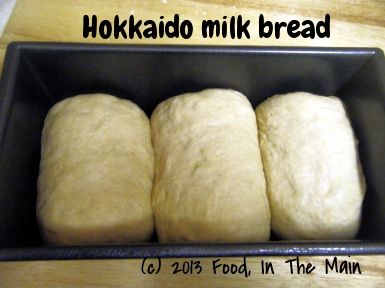
Cover with a towel and leave the dough to rise for about 45 minutes.

To make the rolls fold them in the same manner described above, but before rolling them up, put in the filling.

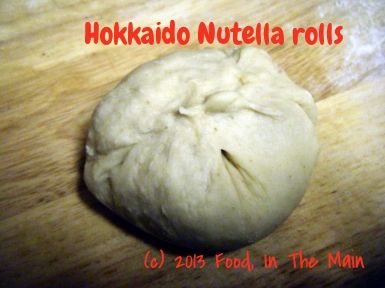
Turn the roll over so the seam side is down, and shape it with both hands, sort of cupping it so that the top is smooth and tight, and the underside is sealed.

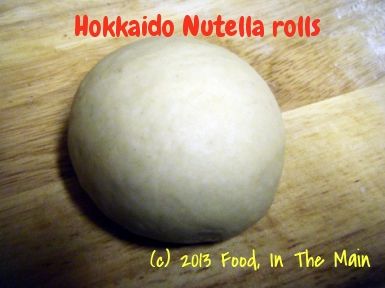
Carefully brush the tops of the rolls and the loaf with milk (or cream) and bake them at 170C (325F) for about 20 to 30 minutes till they are done (if you tap them they’ll sound hollow) and beautifully browned on top.
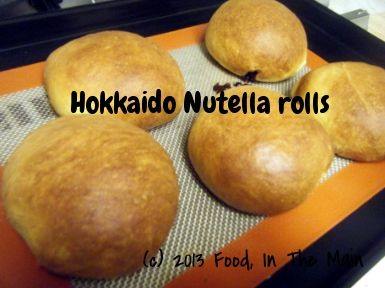
Let them cool on the tray for about 5 minutes and then transfer to a rack till slightly warm or cool.

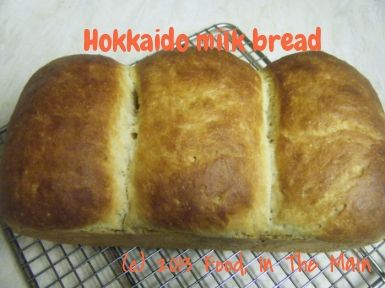
Serve or else store in a bread bin. This bread stays soft and delicious even the next day. This recipe makes enough dough to make one loaf (9” by 5” tin), 2 small loaves (6” by 4” tins) or 1 small loaf (6” by 4”) and 6 small rolls (muffin tins).
Man, I have to say I'm beginning to find it really difficult to come up with something to say for every post. Usually when I stop thinking too hard about what to write, I tend to unblock the stoppage, as it were... but this is beginning to work less and less often.
I've actually thought about not writing anything at all, just posting the recipe and a couple of photos, but I don't know how well that would work.
I mean, when I go to a food blog and find nothing there but the recipe, I get annoyed, even if the recipe is fantastic. I need at least one photo. If there is a photo or two, or even many photos, but no write-up to go with the recipe, that makes me feel annoyed too.
So you'd imagine that when there is a recipe, a photo or two (or even many photos) and a write-up to boot, I'd be a happy camper? Reasonable assumption, right?
Nope.
You see, I'm unreasonable in my wants. I'm not content with just a recipe, a photo or two (or even many photos), and a write-up. No, I want that write-up to be funny and warm and honest and interesting and readable and at the very least I want the recipe to be fabulous - in other words, pretty much like any post you'd care to choose from the lovely Nupur's wonderful blog One Hot Stove.
Unfortunately it is not given to many of us to successfully combine humour and warmth and honesty and readability and foster a loyal readership of our blog... so we just have to struggle on. And if for some people it's a struggle to write a decent post, it's a struggle for others to read a dull one - even if they know how hard it is to actually write a post, never mind pleasing anyone with it!
And on that philosophical note, I guess I will say a few words about this recipe before I close. You will know some of the words, like "variation of Dan Lepard recipe", "The Guardian newspaper", "minimal kneading" and "tasty", so I'll just say the ones that you may NOT know, which is "tighter crumb because I added spelt flour".
Recipe for: Wheat-spelt milk bread
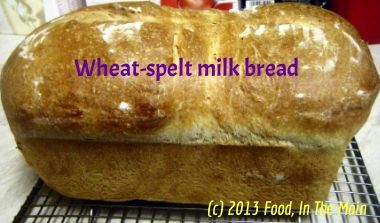
Ingredients:
2-1/4 cups strong white bread flour
1/4 cup very strong wholewheat bread flour
1/2 cup wholemeal spelt flour
100 ml warm water
200 ml warm whole milk
1 tsp quick-rise yeast
1-1/4 tsp salt
Oil for kneading
Flour for sprinkling
Butter for greasing 7" x 5" loaf pan
Method:
1. Mix together the flours in a big bowl and whisk in the salt and yeast. Then make a hole in the centre and pour in the yeast and warm milk-water mixture. Mix together with a wooden spoon until the dough comes together in a rough ball. Cover the bowl and let the dough rest for 10 minutes.
3. Lightly oil your work area/kneading board and scrape the dough onto it. It will be quite sticky. Knead lightly for 10 seconds. Then put the dough back in the bowl, cover it and let rest for 10 minutes. Repeat this cycle twice more, oiling the work area lightly each time, if required.
4. After the fourth 10-second knead, the dough should be elastic and not very sticky. This time, let the dough rise in the covered bowl for 40 minutes to an hour, or till doubled.
5. Now punch the dough down gently. Lightly flour the work area and pat the dough into an oblong, then roll it up and place it in your buttered 7" x 5" loaf pan. Flour the top of the dough, cover with a clean tea towel and let the dough rise in a warm draught-free area for 45 minutes to an hour - it should be at least 1" over the rim of the loaf pan.
6, Preheat the oven to 200C/450F and place a dish of boiling water on the floor of the oven. Bake for 30-40 minutes, or till the loaf is golden brown on top and sounds hollow when tapped on the bottom. Let cool before slicing.
This recipe is from... but I bet you already KNOW where it's from and whose it is. You won't even have to guess. Thaaaaat's right. Dan Lepard, the latest man in my life. He's only lately been in my life, though. Until a couple of weeks back, my No. 1 baking man was Hollywood. Paul Hollywood.
I don't know about you folks outside the UK, but in the UK, The Great British Bake-Off is one of the most watched baking shows. And with good reason... one of the judges, the man with ice-blue eyes, Paul Hollywood, is most watchable. Eminently watchable. Even more than the show, much as I love it. So, carried along by the rush of my crush, I bought his book "How To Bake".
It's a good book, don't get me wrong - it's got good photos of him and his breads, and there are recipes I want to try. But a lot of them require a Kitchen Aid-type of food processor (if that's what they're called), with a dough hook. I don't have a dough hook, much less a Kitchen Aid. In my kitchen, my arms are my aid. So until I get one of them Aids (erk... not meant the way that sounds!), or figure out how to get around not having a hook (being fairly sure that Abu Hamza al-Masri would not be amenable to helping me out), I'll just have to stick with recipes that require arm-power, not hook-power.
Which brings me back to Dan Lepard who, going by his photo in The Guardian, is not an ice-blue-eyed killer-smiled baking heart-throb... but - and this is a BIG but - his baking recipes are doable. As eminently doable as Paul Hollywood is eminently watchable. For the time being, doability trumps watchability. And that, my friends, is saying a LOT!
 Recipe for: Wheat-rye cider loaf
Recipe for: Wheat-rye cider loaf
Ingredients:

1 tsp fast action yeast
1 tbsp agave nectar or honey
150 ml warm water
175 ml dry cider
375 gm (2-3/4 cups) strong white bread flour
75 gm wholegrain rye flour (just over 1/2 cup)
50 gm olive oil
1.5 tsp salt
a little oil for kneading (if required)
Method:
1. Mix the water and cider in a big bowl, then stir in the yeast and syrup till dissolved.
2. Add the olive oil, bread flour and rye flour to the bowl, and finally the salt. Stir quickly and evenly until mixed, and the dough comes together into a rough ball. Cover the bowl and leave it for 10 minutes.
3. Now lightly oil your worktop or kneading board, and scrape the dough onto the board. Knead lightly for 10 seconds, then return the dough to the bowl. leaving it to rest for 10 minutes. Repeat the kneading/resting procedure two more times.
4. After the third time, put the dough back into the bowl and let it rise undisturbed until it's puffy and looks like it has more or less doubled in size. Lightly flour the worktop/board. Punch the dough down and put it on the floured board. Pat it or use a rolling pin to shape it into a rough rectangle with the long side facing you.
5. Now roll up the flattened dough from the far end towards you, as tightly as you can manage it. Place it seam-side down on a tray lined with nonstick baking paper. Cover with a clean cloth and let it rise for 1-2 hours or till it has risen again.
6. Heat the oven to 220C (200C/425F in a fan-assisted oven). Cut a 1-cm deep slash down the centre of the loaf and bake it in the hot oven for about 40 minutes or till golden brown on top and hollow-sounding when tapped on the bottom.
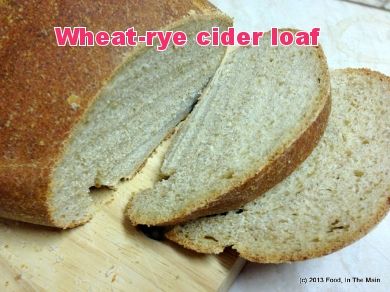
Let cool before slicing.
 Original version of the recipe on Fine Cooking
Original version of the recipe on Fine Cooking
Aparna's post on her blog My Diverse Kitchen
Let's get one thing clear from the start - making croissants was not my first choice, nor even my hundredth choice. In fact, it didn't even figure as a fleeting choice on my "would like to try" list. But I made them. I made them because it was the recipe for February in the "We Knead to Bake" challenge. There is no way that I would have tried this otherwise, none. I cannot stress that enough. I wish I could say that I enjoyed the three-day process so much that I wanted to do it all over gain... I COULD say it, but it would be a big fat lie.
Do you think this might be a bit of a negativity overkill?
Ok, to be fair, I'm glad I tried the recipe. Glad that Aparna made me go way outside my comfort zone (it took me a week to make my way back - ha ha). Glad that I know how much hard work goes into making the flaky, buttery, delicious croissants that I love. Glad that there are bakeries and cafes where I can walk in and simply buy a croissant. And, most of all, glad that faced up to my croissant demon... and if I didn't quite vanquish it, at least I can say truthfully that I didn't just give up.
My croissants were reasonably good, more than edible (jeez, all that butter - why WOULDN'T they be tasty!), and the ones with chopped chocolate filling were actually extremely moreish. I only did a few of those, though, perhaps about 4. The rest were plain croissants. While Pete liked them, and so did I, I just felt that the end result was not good enough for the effort that went into making them. I guess I'm just being picky, and I guess that's because I do love a well-made, fresh, flaky croissant.
I think I need a tame croissant baker who would be at my beck and call for baked goods. Any takers?
 Recipe for: Classic croissants
Recipe for: Classic croissants
Ingredients:
For the dough:
2 cups all-purpose flour, and a little more for dusting/ rolling out dough
1/4 cup plus 1 tbsp cold water
1/4 cup plus 1 tbsp cold milk (I used 2%)
1/8 cup granulated sugar
20gm soft unsalted butter (1.5 tbsp)
1/2 tbsp plus scant 1/4 tsp instant yeast
1 tsp salt
For the butter layer:
125 gm cold unsalted butter
Or 1 egg for egg wash
Finely chopped dark or plain chocolate for filling (optional)
Method:
Day 1 - Make the dough (and refrigerate overnight)
Combine all the ingredients for the dough in the bowl of a stand mixer fitted with the dough hook. You can also use a food processor with the plastic blade, or do this by hand.
Mix everything on low speed for 3 minutes, scraping the sides of the mixing bowl once if necessary. Then mix further on medium speed for 3 minutes. Lightly flour a 10-inch pie pan or a dinner plate. And place the ball of dough on this.
Gently shape the dough into a flat ball by pressing it down before storing it in the fridge, this makes rolling out next morning easier. Making a tight ball will strengthen the gluten which you do not need. Lightly dust the top of the dough with flour and wrap well with plastic so it doesn’t dry out. Refrigerate overnight.
Day 2 - Make the butter layer
The next day, cut out 2 pieces of parchment or waxed paper into 10” squares each. Cut the cold butter into 1/2-inch-thick slabs. Place these pieces on one piece of parchment/ waxed paper so they form a 5- to 6-inch square. Cut the butter further into pieces as required to fit the square. Top with the other piece of parchment/ waxed paper.
Using a rolling pin, pound the butter with light, even strokes. As the pieces begin to stick together, use more force. Pound the butter until it flattens out evenly into a square that’s approximately 7-1/2”. Trim the edges of the butter to make a neat square. Put the trimmings on top of the square and pound them in lightly with the rolling pin. Refrigerate this while you roll out the dough.
Laminate the dough
Unwrap and lay the dough on a lightly floured work surface. Roll it out to a 10-1/2-inch square, and brush off the excess flour. Take the butter out from the refrigerator —it should be cold but pliable. If it isn’t refrigerate it till it is. This so that when you roll out the dough with the butter in ti, neither should it be soft enough to melt, or hard enough to break. Unwrap the butter and place it on the square of dough in the centre, so that it forms a “diamond” shape on the dough.
Fold one flap of dough over the butter toward you, stretching it slightly so that the point just reaches the middle of the butter square. Bring the opposite flap to the middle, slightly overlapping the previous one. Similarly repeat with the other two so that the dough forms an envelope around the butter. Lightly press the edges together to completely seal the butter inside the dough to ensure the butter doesn’t escape when you roll out the dough later.
Lightly flour the top and bottom of the dough. With the rolling pin, firmly press along the dough uniformly to elongate it slightly. Now begin rolling instead of pressing, focusing on lengthening rather than widening the dough and keeping the edges straight.
Roll the dough into an 8” by 24” rectangle. If the ends lose their square shape, gently reshape the corners with your hands. Brush off the excess flour. Mark the dough lightly equally into three along the long side. Using this as a guideline, pick up one short end of the dough and fold 1/3rd of it back over the dough, so that 1/3rd of the other end of dough is exposed. Now fold the 1/3rd exposed dough over the folded side. Basically, the dough is folded like 3-fold letter before it goes into an envelope (letter fold). Put the folded dough on a floured baking sheet, cover with plastic wrap, and freeze for 15 to 20 minutes to relax and chill the dough.
Repeat the rolling and folding, this time rolling in the direction of the two open ends (from the shorter sides to lengthen the longer sides) until the dough is about 8” by 24”. Once again fold the dough in thirds, brushing off excess flour and turning under any rounded edges or short ends with exposed or smeared layers. Cover once again with plastic wrap and freeze for another 15 to 20 minutes.
Roll and fold the dough exactly in the same way for the third time and put it baking sheet. Cover with plastic wrap, tucking the plastic under all four sides and refrigerate overnight.
Day 3 - Divide the dough
The next day, unwrap and lightly flour the top and bottom of the dough. Cut the dough along the longer side into halves. Cover one half with plastic wrap and refrigerate it while working on the other half.
“Wake up the dough up” by pressing firmly along its length with the rolling pin. Don’t widen the dough but simply begin to lengthen it with these first strokes. Slowly roll the dough into a long and narrow strip, approximately 8” by 22”. If the dough sticks as you roll, sprinkle with flour.
Once the dough is about half to two-thirds of its final length, it may start to resist rolling and even shrink back. If this happens, fold the dough in thirds, cover, and refrigerate for about 10 minutes; then unfold the dough and finish rolling.
Lift the dough an inch or so off the table at its midpoint and allow it to shrink from both sides and prevent the dough from shrinking when it’s cut. Check that there’s enough excess dough on either end so that when you trim the edges to straighten them, you have a strip of dough that is 20’ inches long. Now trim the edges so they’re straight. Cut the dough into equal sized triangles, marking them off first if you prefer, before cutting.
Shape the croissants
Now work with one piece of triangular dough at a time. Using your rolling pin, very lightly roll (do not make it thin but only stretch it slightly) the triangle to stretch it a little, until it is about 6” long. This will give your croissants height and layers. You can stretch it by hand too, but if you don’t have the practise, your stretching could be uneven.
Using a sharp small knife, make a 1/2- to 3/4-inch-long notch in the centre of the short side of each triangle. The notch helps the rolled croissant curl into a crescent.
Place the triangle on the work surface with the notched side closest to you. This is the time to add your filling, if you're using any. With one hand on each side of the notch, begin to roll the dough away from you, towards the pointed end.
Flare your hands outward as you roll so that the notched “legs” become longer. Roll the triangle tight enough but not too tight to compress it, until you reach the “pointy” end which should be under the croissant.
Now bend the two legs towards you to form a tight crescent shape and gently press the tips of the legs together (they’ll come apart while proofing but keep their crescent shape).
Shape all the triangles like this into croissants and place them on a greased or parchment lined baking sheet leaving as much space between them as they will rise quite a bit.
Proof the croissants
Brush the croissants with milk (or a mix of milk and cream). If you use eggs, make an egg wash by whisking one egg with 1 tsp water in a small bowl until very smooth. Lightly brush this on each croissant.
Refrigerate the remaining milk/ milk+cream (or egg wash) for brushing the croissants again later. Place the croissants in a cool and draft-free place (the butter should not melt) for proofing/ rising for about 1 1/2 to 2 hours. They might need longer than 2 hours to proof, maybe as much as 3 hours, so make sure to let croissants take the time to proof. The croissants will be distinctly larger but not doubled in size. They’re ready if you can see the layers of dough from the side, and if you lightly shake the sheets, the croissants will wiggle.
Bake the croissants
Just before the croissants are fully proofed, pre-heat your oven to 200C (400F) in a convection oven or 220C (425F) in a regular oven. Brush the croissants with milk/ milk+cream (or egg wash) a second time, and place your baking sheets on the top and lower thirds of your oven (if regular) or bake one tray at a time in the convection oven.
Bake them for about 15 to 20 minutes till they’re done and golden brown on top and just beginning to brown at the sides. In a regular oven, remember to turn your baking sheets halfway through. If they seem to be darkening too quickly during baking, lower the oven temperature by 10C (25F). Cool the croissants on the baking sheets on racks.
Serve warm. This recipe makes 10 mini croissants.
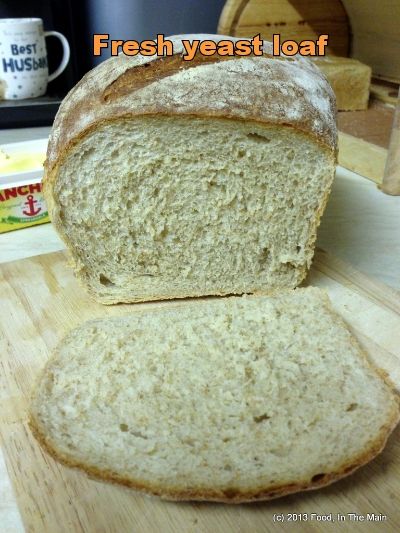
This is yet another Dan Lepard recipe, kind of - that is, I took his basic never-fail white loaf recipe, substituted quick-rise with fresh yeast, changed the flour content to 2:1 white to wholewheat, substituted 1 cup water with 50ml Greek yogurt thinned with 50ml water and, as a final touch, added 1 tbsp vinegar because I'd read somewhere that it helped keep the loaf soft for longer.
Perhaps I should have made one substitution at a time per loaf, rather than all the substitutions in one loaf - because I can't say for sure if it was the yogurt or the vinegar or the combination that actually made the loaf come out so well! What I CAN say for certain is that this was a lovely, lovely loaf - rose well, baked well, sliced well, toasted well...
I might be blowing my own trumpet here a wee bit, but... it might just be that I've got my bread baking mojo back!
Recipe for: Fresh yeast white-wholewheat loaf
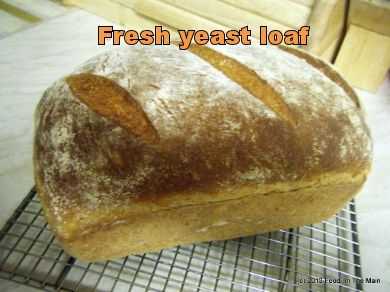
Ingredients:
2-1/2 cups strong white white flour + 1 cup strong wholewheat flour
30gm fresh yeast OR 1 tsp dry instant/quick-rise yeast
1 tsp sugar
1-1/2 tsp salt
200 ml warm (NOT hot) water
50 ml Greek yogurt + 50 ml water
1 tbsp vinegar (I used apple cider vinegar)
a little oil for kneading
Method:
1. Check that the yeast is alive by crumbling it into the warm water along with 1 tsp sugar, and whisking it. Leave it for 15 minutes. If it's starting to bubble, it's alive and can be used successfully. (If you're using instant yeast, skip this step and go straight to step 2, adding the instant yeast to the flour.)
2. Put the flours in a bowl and whisk in the salt. Make a well in the middle and pour in the yeast starter along with the yogurt and vinegar. Mix to form a rough dough. Cover and let it be for minutes.
3. Now oil your worktop or kneading board lightly, and scrape the dough onto it. Knead lightly for 10 seconds, then let it rest for 10 minutes. Do the kneading/resting procedure twice more, for a total of three times, oiling the board and/or your hands as required.
4. After the fourth 10-second knead, put the dough back in the bowl, cover it, and let it rise for 45 minutes to an hour, or until it has doubled.
5. Lightly flour the kneading board. Punch down the dough and return it to the kneading board, rolling it gently or patting it into a rough oblong. Now roll it up tightly along the long side, and place it seam-side down on a floured tray. You can also place it in a lightly greased 7" x 5" loaf tin. Either way, flour the top of the loaf, cover it with a clean tea towel and leave it to rise for another hour or so. When the dough looks like it has more or less doubled, or when it is about 2 inches above the rim of the tin, make a 1cm deep cut down the middle with a sharp knife, or three diagonal slashes - whichever way you prefer it.
6. Preheat the oven to 200C/425F. Just before putting the bread in to bake, place a tray of boiling water on the oven floor. The steam will help the crust become a rich colour. Bake the bread for about 35-40 minutes. The bread is done when the top turns golden brown and the bottom sounds hollow when it is tapped. Let cool before slicing.
I've been on a baking binge over the last 2 weeks - only on the weekends, though, because weekdays are just not long enough for baking bread if you're not demonically organised, which I am not.
Ever since I discovered Dan Lepard's recipes in The Guardian, I've gone through some 300-odd recipes in his column published over the past so many years, and scouted out all the bread recipes that seemed interesting and easy. And printed them. And now I'm trying to bake them all, one by one.
The saffron bloomer got made twice. Then this one, which is really good. There's also a wheat & rye cider loaf, and a loaf made with fresh yeast... but I'm getting ahead of myself. Those recipes will follow in due course.
For this loaf, it was serendipitous that I had half a carton of sour cream in the fridge. It may have been just a teensy bit past its use-by date, but I didn't say that and you didn't read it. Besides, we're both alive, so there was no harm done.

I've never been so pleased with bread I've baked - this loaf could have come from a proper bakery, I kid you not. I SO like Dan Lepard, because he says there's no need to knead like a maniac to get good bread, and believe me, that man speaks true. I'm all for an easier life, and he does make it easier. I may have said that before, but it remains true nevertheless.

Recipe for: Sour cream loaf
Ingredients:
125g (4 oz or 1/2 cup) cold sour cream
1.5 tsp salt
2 tsp caster sugar
1 sachet (7g) fast action yeast
550g (1 lb 4 oz) strong white bread flour, plus more for shaping
Oil, for kneading
Method:
1. In a large bowl, mix the sour cream with 150ml cold water and 100ml boiling water.
2. Add the sugar and yeast and whisk it together, then mix in the flour and salt until it forms a rough ball. It will be quite sticky. Cover the bowl and leave the dough to sit for 10 minutes.
3. Lightly oil your working area (worktop or kneading board) and gently knead the dough on it for 10 seconds. Put the dough back in the bowl and let it rest covered for 10 minutes.
4. Repeat the 10-second-kneading/10-minute-resting procedure twice more, oiling the worktop again if required to stop the dough from sticking too much. After that, leave the dough covered in its bowl for an hour or so, until it has doubled in size.
5. Butter the base and sides of a large, deep, 8" (19cm) loaf tin. Line the base with non-stick baking paper.
6. Lightly flour the kneading board now and place the punched-down dough on it. Pat or roll it out into 1 2-cm thick rectangle that's the length of the loaf tin, then roll the dough up towards you as well as you can. Place it seam-side down in the loaf tin, flour the top lightly, cover with a towel and let it rise for 60-90 minutes until it is doubled again.
7. Bake at 200C (180C/350C for fan-assisted or convection ovens) for about 45 minutes till it is golden brown on top and sounds hollow when you tap the loaf on the bottom (you gotta remove it from the baking tin for this, so definitely use oven gloves!).
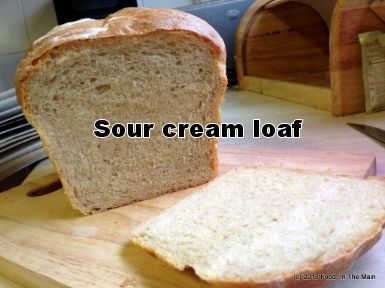
Let cool before slicing.
Chana dal sundal (cooked chana dal stir fried in spiced oil with mustard seeds) is one of my favourite things to eat as a side dish with rice and mor kuzhambu. I like to mix the rice and sundal together (as weird as that may sound), which is why I thought that this recipe would work. There's no mor kuzhambu involved this time, though. Just the rice and chana dal. Oh, and some vegetables.
If you think about it, recipes that combine protein, carbs and vegetables in a tasty package have to be top of the list for those occasions where you don't want to spend ages in the kitchen but also don't want to be tempted to order a takeaway. This recipe takes about 30 minutes from start to finish, especially if you prep and cook the vegetables while the rice is cooking. If you have leftover rice, this recipe is even quicker to make. And it tastes lovely.
A word of warning with regard to the chana dal - because it's easy to cook it to mush, I don't add any extra water while cooking it with the rice. I like my chana dal very slightly undercooked so that it still has a gentle bite. If you prefer it well soft, feel free to add another 1/8 cup of water while cooking the rice & dal.
Recipe for: Chana dal-vegetable masala rice

Ingredients:
1 cup basmati rice
1/4 cup chana dal
1 medium potato, chopped into small cubes
1/4 cup sliced runner beans (or green beans)
1 medium tomato, chopped
1 fat clove garlic, sliced
2 medium onions, sliced thin
1 tbsp oil
3-4 green chillies, sliced (to taste)
1 tsp chana masala/garam masala/curry powder
1 tsp cumin seeds
Salt to taste
Chopped coriander leaves for garnish
Roasted peanuts, for garnish (optional)
Method:
1. Wash and soak the basmati rice and chana dal together for 15 minutes. Then place in a saucepan along with 2 cups water over high heat. When the water begins to bubble and holes appear in the rice, stir the rice, turn down the heat to the lowest setting, and cover the pan with a lid placed over a clean tea towel (the towel will absorb the steam). Let it be for about 8-10 minutes, then turn off the heat. Let the rice stay undisturbed for 10 minutes so that it can absorb the moisture, then fluff it up.
2. While the rice is cooking, heat the oil in a saute pan until it shimmers, add the cumin seeds and fry them for 10 seconds, then add the green chillies and garlic and stir-fry for 30 seconds or so. Stir in the onions and cook them till they turn soft.
3. Now add the chopped tomato, potato and runner beans/green beans and stir well. Cover the pan and cook on simmer for 10-15 minutes, till the vegetables are done. Stir in the chana masala/garam masala/curry powder and salt to taste.
4. Finally, add the rice-chana dal and mix it in gently but thoroughly with the vegetable masala. Sprinkle with coriander leaves and peanuts, and serve hot with any raita.
I made a version of this soup last month when I was with my family in Seattle, to go with the herby cheese pull-apart bread that was our first baking challenge set by Aparna Balasubramaniam. The soup is not exactly as I made it the first time, because mixed vegetable soup can be whatever you make of it.

If you're a wannabe Masterchef contestant or judge, or have more money than sense, you can use expensively exotic ingredients - mushrooms that have been grown in soil imported from a remote corner of the Brazilian rain forest and watered with dew gathered in moonlight on a full moon night in June; the rarest blue-spotted heirloom potatoes from Venezuela that have been hand picked by an endangered tribe (gotta support them, don't y'know); cream from milk where the cattle were exclusively hand fed on the finest grass prepared by Cordon Bleu chefs while classical music was played by the London Philharmonic live in their air-conditioned, state-of-the-art barn (the cows' barn, I mean, not the London Philharmonic's. The London Philharmonic wouldn't be allowed to live in the same building as these super-exclusive posh cows!)... you get the idea.
OR, you could just use whatever vegetables you have in your refrigerator that need using up, and standard chestnut or white mushrooms (or whatever you can get), to make this soup. It's a guide more than a recipe, anyway.
That said, though, I bought the mushrooms specifically to make this soup. But because I have more sense than I have money, I bought them from the "reduced for quick sale" section. Yay me!
Recipe for:
Vegetable-mushroom soup

Ingredients:
4 small onions, sliced thinly
2 baby leeks (green and white parts), sliced thinly
4 cups mixed mushrooms (I used portobello/cremini, shiitake and oyster), sliced
1 medium potato, chopped (skin on)
1 medium carrot, chopped
1 litre (4-5 cups) vegetable stock/broth
1 tsp dried thyme or Italian herb mix
1 bay leaf
4 sprigs fresh thyme
1 tbsp olive oil + 1 tbsp butter
2 tbsp sour cream/Greek yogurt or full fat milk (optional)
Salt and pepper to taste
2 tbsp parsley for garnish
Method:
1. Heat the oil and butter in a large pan, add the onions and leeks and cook over medium heat till they begin to soften (about 5 minutes), stirring frequently.
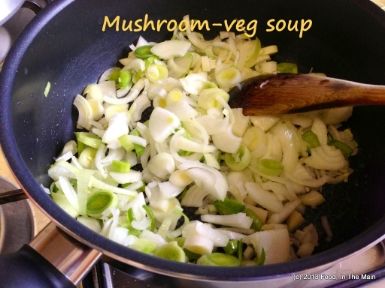
2. Add the mushrooms and cook for 2-3 minutes or till they start to reduce.

3. Add the potatoes and carrots along with the dried herbs and bay leaf. Stir for a couple of minutes.
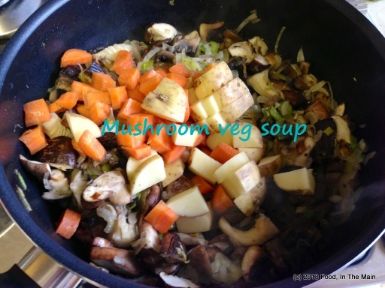
4. Then add the stock and the fresh thyme sprigs.

Bring this to a boil, cover the pan and let the stock simmer for 10-15 minutes or till the carrots and potatoes are soft and cooked.
5. Fish out the fresh thyme sprigs and bay leaf, then turn off the heat. Let the soup cool, then blend it to a smooth consistency.
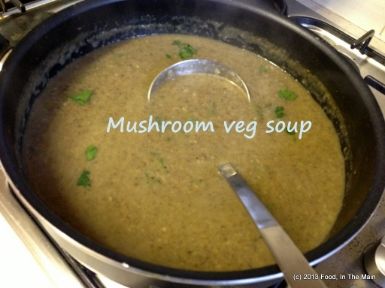
If you would like a bit more texture to the soup, blend only about 3/4 of the soup smooth, then add it to the remaining unblended soup in the pan. Add the milk or sour cream/yogurt, if using, and stir it in. Add salt and pepper to taste. Reheat on low heat till thoroughly warmed, but do not let it boil. Serve with parsley sprinkled on top, and croutons if you like, and crunchy buttered toast on the side.
This recipe is pretty much exactly as detailed by Dan Lepard in The Guardian newspaper. It just seemed like a simple thing to make, and it pretty much was. While I like kneading bread, it's also a nice change to NOT have to knead bread. This bread doesn't need much effort, just 30 seconds of light kneading in total, 10 minutes apart. What's not to like?
The saffron taste and aroma was gentle but there, and the bread was just lovely. The most it takes up is time, and I watched two movies while waiting for the dough to prove. They were "Premonition", starring Sandra Bullock, and "One Small Hitch", starring an actor called Shane McRae. The first was a sort of paranormal suspense move, and the second a light comedy. While I really like Sandra Bullock, the movie itself was pretty much a clunker - I don't like unhappy endings, so that just made it worse. Shane McRae was pretty cute, though. I thought "One Small Hitch" was a good timepass movie.
And now, because this is meant to be a food blog, I will stop here and dream about Shane McRae in private. Do try this lovely bread, though. I'll be making it again for sure.
P.S. It makes fantastic toast! Try it with marmalade and peanut butter (or ok, maybe that's just me).
 Recipe for: Saffron bloomer loaf
Recipe for: Saffron bloomer loaf
Ingredients:
A good pinch or two of saffron
150ml boiling water
150ml cold water
1 tsp fast-action yeast
100g ricotta
500g (4 cups) strong white bread flour, plus extra for shaping
50g (1/2 cup) wholemeal flour
2 tsp fine salt
Oil, for kneading
Method:
1. Put the saffron in a large mixing bowl, pour on the boiling water and leave for 10 minutes. Then add the cold water and yeast, stir well to dissolve the yeast, crumble in the ricotta and mix well.
2. Add the flours and salt, mix everything to a smooth dough, then cover and leave for 10 minutes.
3. Now lightly oil a kneading board or your kitchen worktop, and knead the dough lightly for 10 seconds. Return the dough to the bowl, leave for 10 minutes, then repeat this light knead twice more at 10-minute intervals, before leaving the dough, covered, for about an hour.
4. Lightly flour the worktop, pat the dough into a rectangle and roll up very tightly. Place the dough seam-side down on a tray lined with nonstick paper, lightly flour the top, cover with a cloth and leave for an hour until it nearly doubles.
5. Slash the risen dough three or four times with a sharp knife along the top,
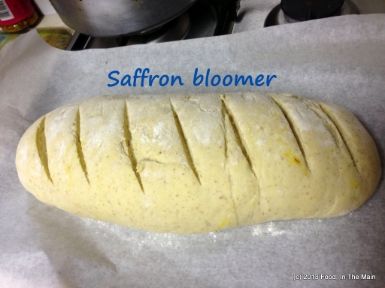
and bake at 220C (200C fan-assisted)/425F/gas mark 7) for about 40 minutes.
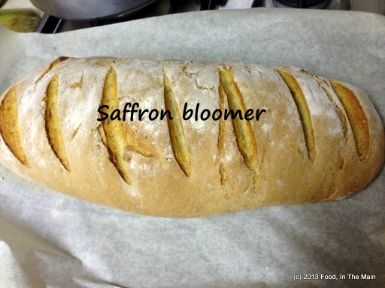
Tip: Fill a metal dish with boiling water and place on the lowest shelf of the oven, before putting the dough in to bake, to help give the your loaf's crust a golden colour.





















































